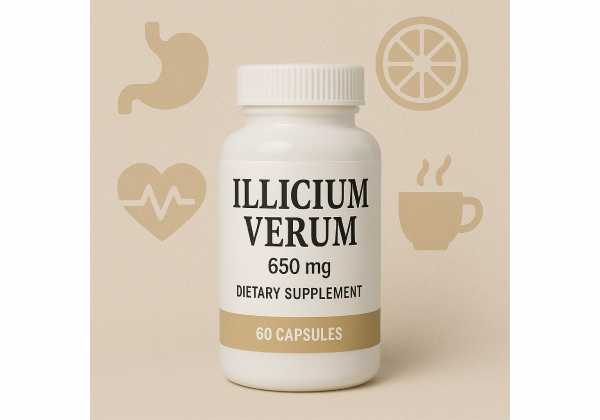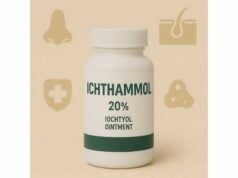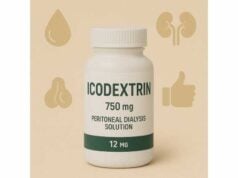
Star anise (Illicium verum) is the star-shaped fruit of an evergreen tree native to southern China and Vietnam. In the kitchen, it lends warm licorice notes to broths, chai, and baked goods. In traditional medicine, it has long been used for coughs, digestive discomfort, and seasonal ailments. Modern analysis shows the fruit and its essential oil are rich in trans-anethole and other aromatic compounds with antioxidant, antimicrobial, and soothing properties. Star anise is also an industrial source of shikimic acid, a raw material used to manufacture certain antivirals—though the spice itself is not an antiviral drug. This guide offers a clear, practical view of what Illicium verum can and cannot do, how to use it safely at home, what to look for when buying products, and when to avoid it. You will find doses for tea and culinary use, safety flags, potential interactions, and a concise evidence snapshot at the end.
Quick Overview
- May ease mild gas, bloating, and spasms; pleasant warming effect on digestion.
- Steam inhalation or tea may temporarily soothe coughs and throat irritation.
- Typical tea: 1–2 whole stars (about 1–2 g) steeped 10–15 minutes, up to 2–3 times daily.
- Avoid in infants and young children; risk of adulteration with toxic Japanese star anise.
- Do not ingest essential oil; pregnant or breastfeeding people should seek medical advice first.
Table of Contents
- What is Illicium verum?
- Benefits you can expect
- How to use it right
- Quality and buying guide
- Common mistakes and fixes
- Safety, side effects, and interactions
- Evidence at a glance
What is Illicium verum?
Illicium verum Hook. f., commonly called Chinese star anise, is a small evergreen tree in the Schisandraceae family. Its woody, eight-pointed fruits are harvested just before ripening and dried until glossy brown. Each “arm” contains a shiny seed, but most of the spice’s aroma and bioactive constituents are in the pericarp (the star-shaped husk), not the seed.
Chemically, star anise is dominated by trans-anethole (often 70–90% of the essential oil), which provides the classic sweet, anise-like scent. Other constituents include anisaldehyde, estragole (in small amounts), limonene, linalool, and shikimic acid in the non-volatile fraction. These molecules contribute to flavor, fragrance, and observed biological activities such as smooth-muscle relaxation, spasmolysis in the gut, and antimicrobial effects in vitro.
A crucial safety point is species identity. Illicium verum is distinct from Illicium anisatum (Japanese star anise), a visually similar plant that contains neurotoxic sesquiterpene lactones (e.g., anisatin). Japanese star anise is not a food spice and has caused neurological reactions when mistakenly consumed as “tea.” Trusted suppliers should test and verify species identity to prevent adulteration.
In traditional Chinese and Vietnamese cuisines, star anise is part of five-spice blends, braised meats, pho broth, and herbal tonics. In many folk systems, it is brewed as a warming digestif after meals, combined with ginger, cinnamon, or fennel to reduce post-prandial bloating and support comfortable digestion. Topically, diluted essential oil is a fragrance component in balms, soaps, and dental care products for its fresh, sweet aroma.
Finally, star anise is an industrial botanical source of shikimic acid. This natural compound is a precursor used in synthesis pathways for certain antiviral medications. This does not make star anise itself an antiviral drug; the pharmaceutical conversion requires multiple chemical steps under controlled conditions.
Benefits you can expect
Digestive comfort (carminative and antispasmodic). Traditional use and laboratory work point to smooth-muscle relaxation in the gastrointestinal tract. Many people experience reduced gas and cramping when sipping star-anise tea after meals or incorporating the spice into slow-simmered dishes. The pleasant warmth may also nudge salivation and gastric secretions, supporting digestion of hearty foods.
Temporary relief for upper-airway irritation. Warm herbal infusions and aromatic steam can moisten the throat and loosen mucus. The volatile constituents in Illicium verum impart that “open, warming” sensation. As with other aromatic herbs, this is symptomatic relief—useful during colds for comfort, but not curative.
Oral-care freshness and surface hygiene. Anise-scented essential oils are widely used for breath freshening. Trans-anethole contributes to a clean taste and has demonstrated antimicrobial activity in laboratory settings. In real life, the value is mainly palatal freshness and enjoyment of flavor; it’s not a substitute for brushing, flossing, or dentist visits.
Culinary antioxidant contribution. Dried culinary spices deliver modest amounts of phenolics and terpenes that help protect foods from oxidation and add sensory richness. In a balanced diet, regularly cooking with spices like star anise layers small, diverse phytochemical exposures that may support overall dietary quality.
Comfort during seasonal ailments. Many traditional recipes combine star anise with ginger, cinnamon, and licorice for warming teas. While evidence from controlled human trials is limited, the combination often feels soothing, promotes hydration, and can make broths more appealing when appetite is low.
What it does not do. Despite popular claims, star anise tea is not nature’s version of any antiviral medication. Shikimic acid in the plant is only a starting material used in complex manufacturing; drinking tea does not produce an antiviral drug in the body. Use star anise for flavor, warmth, and gentle symptom comfort—not as a substitute for medical care.
Who may particularly appreciate it.
- Cooks seeking deeper, rounder flavor in stocks, stews, and baked goods.
- Adults with occasional post-meal bloating who enjoy aromatic teas.
- People who like licorice-like flavors and wish to expand their spice library.
Who should be cautious or avoid it.
- Infants and young children.
- Anyone with allergies to anise, fennel, or related Apiaceae/Schisandraceae aromas.
- Pregnant or breastfeeding people without individualized guidance.
- Those using concentrated essential oils internally (not recommended without professional supervision).
How to use it right
Culinary use. Whole stars are potent. For a home pot of broth or stew serving 4–6 people, 1–2 whole stars are usually enough; simmer for 30–60 minutes and remove to avoid bitterness. For desserts (poached pears, compotes, custards), start with 1 star per liter of liquid. Ground star anise is stronger; begin with ¼–½ teaspoon in spice rubs or baking and adjust to taste.
Tea (infusion).
- Single-herb: 1–2 whole stars (≈1–2 g) crushed slightly to expose surface area. Pour 250 ml boiling water, cover, and steep 10–15 minutes. Strain. Up to 2–3 cups per day for short periods is typical for adults.
- Digestive blend: 1 star anise + 1–2 thin slices fresh ginger + a small cinnamon stick. Steep as above.
- Aromatic steam: For temporary nasal comfort, add 1–2 crushed stars to a bowl of hot water and inhale the steam gently with eyes closed for several minutes. This is for adults without asthma triggers; discontinue if irritation occurs.
Topical and aromatic uses. The essential oil of Illicium verum is extremely concentrated. If used in a diffuser, follow device guidance (often 1–3 drops in water) and ensure good ventilation. For leave-on skin products, professional aromatherapy references typically limit anise-type oils to low concentrations (often ≤2% in carrier oil for short-term, localized use). Essential oil should not be ingested; it is not the same as the culinary spice.
Supplements. Commercial capsules or extracts vary widely in strength and standardization. Because authoritative dosing ranges for standardized Illicium verum extracts in humans are not established, the most prudent approach is:
- choose reputable brands with species authentication and contaminant testing;
- follow the product’s serving directions; and
- limit use to short courses for specific goals (e.g., digestive comfort) unless advised otherwise by a clinician.
Timing tips. For digestion, use shortly after meals or in long-simmered dishes. For soothing cough or throat irritation, sip warm tea slowly and hydrate well. Avoid late-night heavy spicing if you are sensitive to aromatic foods at bedtime.
Storage. Keep whole stars in an airtight jar away from heat and light. Properly stored, they retain aroma for 12–18 months. Ground spice fades faster; buy in small amounts and replenish regularly.
Sustainability note. Illicium verum trees take years to mature. Favor suppliers that support responsible cultivation and avoid wild-harvest of scarce Illicium species that can increase adulteration risk.
Quality and buying guide
1) Species identity first. The single most important quality step is verifying that the product is Illicium verum, not Japanese star anise (Illicium anisatum) or other Illicium species. High-quality suppliers:
- state the full botanical name (Illicium verum Hook. f.);
- document country of origin (commonly China or Vietnam); and
- use microscopy, chromatography (e.g., TLC/GC-MS profiles), or DNA authentication to confirm species.
2) Whole stars beat mystery powders. Whole fruits are easy to recognize by eye and nose, reducing adulteration risk. They should be intact, reddish-brown, and fragrant. Excessive broken pieces, dull color, or musty odor suggest poor handling.
3) Safety testing matters. Look for evidence of contaminant checks (heavy metals, pesticides) and microbial quality. For essential oil, request a batch GC–MS report showing a typical trans-anethole-dominant profile and confirming the absence of unexpected constituents.
4) Aroma and flavor tell a story. Fresh star anise smells sweetly licorice-like with a clean, balsamic finish. A harsh, camphoraceous note or tongue-numbing bitterness is a red flag. When in doubt, discard any product with off odors.
5) Ethical and traceable supply. Brands that disclose farm or cooperative partners, harvesting seasons, and processing methods tend to maintain higher standards. Certifications (organic, GMP for supplements) can add assurance, though they are not a guarantee of species identity.
6) For teas and “children’s blends.” Avoid star anise teas marketed for infants or toddlers. Even authentic Illicium verum should not be given to babies. If you buy bagged tea for adults, choose companies that publish species and origin information; avoid vague labels like “anise tea” without the word “star.”
7) Essential oil selection. Choose oils explicitly labeled Illicium verum (star anise) rather than aniseed oil (from Pimpinella anisum), which is a different plant though the aroma overlaps. Confirm child-safety and dermal-use guidance from a credible source; avoid internal use.
8) Storage and shelf life. For whole stars, opaque or amber glass helps protect volatile compounds. Keep away from heat, humidity, and sunlight. Essential oil should be stored in dark glass with a tight cap; oxidation reduces quality and may increase skin-sensitization risk.
Common mistakes and fixes
Mistake: Treating star anise tea like an antiviral medication.
Fix: Use it for comfort only—warm fluids, pleasant aroma, and hydration. Seek proper medical care for flu and other infections.
Mistake: Brewing “star anise tea” for infants.
Fix: Do not give star anise to babies or young children. If a child has colic or cough, consult a pediatric clinician for age-appropriate options.
Mistake: Over-spicing and bitterness.
Fix: Star anise is potent. Start low (1 star per liter of liquid), simmer gently, and remove early. Crushing the star before steeping increases extraction—use fewer pieces.
Mistake: Buying unlabeled powders.
Fix: Purchase whole fruits from reputable suppliers, or buy powders only from brands that provide full botanical identity, origin, and quality testing.
Mistake: Ingesting essential oil.
Fix: Reserve essential oil for aroma (diffuser) or properly diluted topical products if appropriate. Internal use of essential oil is unnecessary and poses risk.
Mistake: Confusing star anise (Illicium verum) with aniseed (Pimpinella anisum).
Fix: Both share an anethole aroma, but they are different species with different plant families and supply chains. Recipes often allow substitution by flavor, but product labeling and safety guidance differ.
Mistake: Assuming “natural means safe for pregnancy.”
Fix: Aromatic herbs can influence smooth muscle and hormones in complex ways; evidence is limited. During pregnancy or breastfeeding, use culinary amounts only and avoid concentrated products unless advised by your clinician.
Mistake: Storing near heat or light.
Fix: Keep in airtight containers in a cool, dark cupboard. Label with the purchase date and refresh yearly.
Safety, side effects, and interactions
Key safety risks to understand
- Adulteration with Japanese star anise (Illicium anisatum). This separate species contains neurotoxic compounds linked with jitteriness, vomiting, rapid eye movements, and seizures when consumed as “tea,” including in infants. Because the fruits look similar, species authentication is critical. Avoid products not clearly labeled with the full botanical name and origin.
- Age considerations. Do not give star anise to infants or toddlers. Neurological events in children have been associated with contaminated teas. For older children and adults, culinary use is generally well tolerated; still avoid “strong teas” in kids.
- Pregnancy and lactation. Reliable human data are limited. Culinary amounts are customary in many cultures, but concentrated preparations (tinctures, essential oil) should be avoided unless your healthcare professional specifically recommends them.
- Allergy and cross-reactivity. If you are allergic to anise, fennel, dill, or related flavors, proceed cautiously; aromatic terpenes may cross-react. Discontinue if itching, hives, wheezing, or swelling occurs and seek care.
- Essential oil hazards. Undiluted essential oil can irritate skin and mucous membranes; ingestion may cause nausea, neurological symptoms, or worse. Keep all essential oils out of reach of children.
Potential interactions
- CNS-active drugs. Because of rare reports of neurological symptoms with adulterated products, avoid star anise teas while taking medications that lower seizure threshold unless your clinician agrees.
- Hormone-sensitive conditions. Trans-anethole has mild estrogenic activity in some experimental systems. People with hormone-sensitive conditions should limit intake to standard culinary amounts and discuss with their clinician before using concentrated extracts.
- Estragole content. Star anise can contain small amounts of estragole, a natural constituent under ongoing safety evaluation in the EU. Practical takeaway: use reasonable culinary quantities, avoid prolonged high-dose use, and do not administer concentrated products to children.
Side effects to watch for
- Heartburn or reflux if heavily spiced meals are eaten late at night.
- Nausea or lightheadedness with very strong brews—dilute or reduce dose.
- Skin irritation with essential-oil contact—use correct dilution or avoid.
When to seek medical advice
- You experience neurological symptoms (tremor, unusual eye movements, seizures), especially after drinking star anise tea—stop immediately and seek urgent care.
- You are pregnant, breastfeeding, have chronic liver or kidney disease, a seizure disorder, or take multiple medications—ask your clinician before using extracts or teas beyond culinary use.
Evidence at a glance
What the lab and reviews show
- Phytochemistry: Illicium verum contains high levels of trans-anethole in its essential oil, plus other aromatic compounds. The non-volatile fraction includes shikimic acid (valued industrially).
- Mechanisms (preclinical): In vitro and animal models report antimicrobial, antifungal, antioxidant, spasmolytic, and modest anti-inflammatory activities. These findings align with traditional digestive and aromatic uses but are not the same as proven clinical effects.
- Quality and adulteration: Multiple assessments emphasize the risk of mixing authentic star anise with Japanese star anise in commerce; robust quality control is needed to prevent neurotoxic exposures.
- Regulatory context: Food and herbal regulators have issued advisories about star-anise teas in the context of adulteration and infant exposure. European assessments continue to evaluate safety for constituents like estragole and for flavoring uses of anethole.
Gaps in human evidence
- Clinical trials: Published, well-controlled human trials specifically testing Illicium verum preparations for defined endpoints (e.g., functional dyspepsia) are limited. Most recommendations rely on traditional use, culinary experience, and supportive lab data.
- Standardized dosing: No consensus adult dose exists for standardized extracts; hence the emphasis on culinary use and cautious, short-term tea consumption.
- Special populations: Safety data in pregnancy, breastfeeding, pediatrics, and people with chronic conditions are insufficient for firm guidance beyond culinary use.
Practical bottom line
For most healthy adults, culinary use of Illicium verum and moderate tea (1–2 stars per cup, up to 2–3 times daily for brief periods) can be a pleasant, warming way to support digestive comfort and soothe the throat. The spice should not be used as an antiviral treatment or given to infants. Choose high-quality, authenticated products to avoid adulteration, and avoid ingesting essential oil.
References
- Illicium verum (Star Anise) and Trans-Anethole as Valuable Raw Materials for Medicinal and Cosmetic Applications 2022 (Review)
- A Comprehensive Review of the Pharmacology, Chemistry, Traditional Uses and Quality Control of Star Anise (Illicium verum Hook. F.): An Aromatic Medicinal Plant 2023 (Systematic Review)
- Center for Food Safety and Applied Nutrition 2003 2003 (Advisory)
- Public statement on the use of herbal medicinal products containing estragole (Revision 1) 2023 (Guidance)
- Safety and efficacy of the feed additives trans-anethole and eugenol for use in all avian species 2025 (Scientific Opinion)
Disclaimer
This article provides general information about Illicium verum (star anise) for educational purposes. It is not a substitute for personalized medical advice, diagnosis, or treatment. Always speak with a qualified healthcare professional about your specific health needs, especially if you are pregnant or breastfeeding, plan to give herbs to a child, have a medical condition, or take prescription medications.
If you found this guide useful, please consider sharing it with friends or colleagues on Facebook, X (formerly Twitter), or any platform you prefer, and follow us for future updates. Your support helps us continue creating reliable, reader-first resources.










